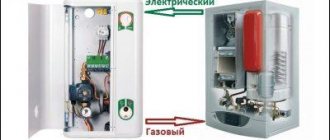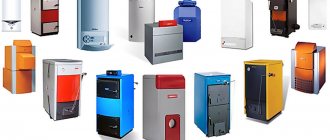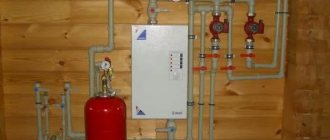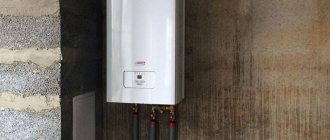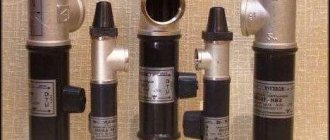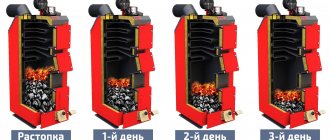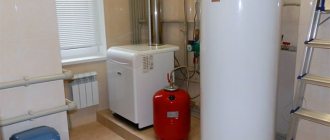Piping the boiler room with a 3-phase induction heating boiler VIN-10
The photo shows that the induction boiler can be placed in a convenient place on the wall. The client wished to install a separate circulation pump for each circuit (floor). The safety group and expansion (membrane) tank are compactly mounted on the outlet pipe of the VIN-10 induction boiler. The control panel is located to the right of the boiler and collectors at a convenient height (depending on the customer’s height). This boiler room was equipped with a GSM module, which allows you to control the temperature in the house and control the induction boiler through a mobile application from a smartphone, anywhere in the world with an Internet connection!
Principle of operation
As you know, metal located in a magnetic field heats up. And if this piece of iron is placed in a water heating circuit, then the coolant circulating through the pipes will take the temperature from it.
Operating principle of the SAV induction boiler
An induction boiler heats up the room faster, but this does not mean that it is more economical than its heater counterpart. Their efficiency is the same.
Induction boilers SAV and VIN and their advantages.
- Economical.
Induction heating boilers VIN and SAV (water heaters) are more economical than conventional heating boilers due to the use of 99% of the energy consumed. - Safety.
Induction heating is a high degree of electrical and fire safety during operation. - Durability.
The service life of induction heaters when used for heating buildings is more than 30 years. - Easy to use.
They do not require preventive maintenance during the heating season and the off-season period, do not require highly qualified personnel for installation and maintenance, and are completely autonomous. - Small sizes.
The small dimensions of the induction heating boiler VIN and SAV allow it to be installed almost anywhere.
Water heaters type VIN
The heart of the unit is a coil consisting of a large number of turns of insulated wire, and placed vertically in a cylindrical housing in the form of a vessel. A metal rod is inserted inside the coil. The housing is hermetically sealed at the top and bottom with welded lids, and the terminals for connection to the electrical network are brought out. Cold coolant enters the vessel through the lower pipe, which fills the entire space inside the body. Water heated to the required temperature goes into the heating system through the upper pipe.
Coolant heating circuit
Due to its design, when connected to the network, the heat generator constantly operates at full power, since it is irrational to supply the heating installation with additional voltage regulation devices. It is much easier to use cyclic heating and use automatic shutdown/on with a water temperature sensor. You just need to set the required temperature on the display of the remote electronic unit and it will heat the coolant to this temperature, turning off the water heating induction element when it is reached. After the time has passed and the water has cooled by a few degrees, the automation will turn on the heating again, this cycle will be repeated constantly.
Since the heat generator winding provides a single-phase connection with a supply voltage of 220 V, induction-type heating units are not produced with high power. The reason is that the current in the circuit is too high (over 50 amperes), it will require laying large cross-section cables, which in itself is very expensive. To increase power, it is enough to put three water heating units in a cascade and use a three-phase connection with a supply voltage of 380 V. Connect a separate phase to each device in the cascade; the photo shows a similar example of the operation of induction heating.
Heating with induction boilers
Design features of heaters of the “Sibtekhnomash” type Using the same effect of electromagnetic induction, another company develops and produces water heating devices of a slightly different design that deserves attention. The fact is that the electric field created by a multi-turn coil has a spatial shape and spreads from it in all directions. If in VIN units the coolant passes inside the coil, then the Sibtekhnomash induction boiler device provides a spiral-shaped heat exchanger located outside the winding, as shown in the figure.
The winding creates an alternating electric field around itself, eddy currents heat the turns of the heat exchanger pipe in which water moves. Coils with coils are assembled in a cascade of 3 pieces and attached to a common frame. Each of them is connected to a separate phase, the supply voltage is 380 V. The Sibtekhnomash design has several advantages:
- induction heaters have a separate, collapsible design;
- in the zone of action of the electric field there is an increased area of the heating surface and a larger amount of water due to the spiral circuit, which increases the heating rate;
- Heat exchanger piping is accessible for cleaning and maintenance.
An example of connecting an induction boiler
Despite the differences in the design of the heat generator, its operating efficiency is 98%, as in heaters of the “VIN” type, this efficiency value is declared by the manufacturer itself. The durability of the units in both cases is determined by the performance of the coils, or more precisely, by the service life of the winding and electrical insulation; manufacturers set this indicator within 30 years.
Savings when using electric heating
There is no gas, it is expensive to deal with diesel or solid fuel. All that remains is electricity. Can you save money by installing an electric heating system?
The new generation of heating systems using induction technology is rightfully classified as energy-saving equipment.
In most cases, induction heaters VIN and SAV reduce operating costs by 30%.
Reliable and durable induction heating systems guarantee warmth and durability - “set it and forget it for 30 years.”
Savings compared to a conventional heating element – 266,218 rubles over 5 years.
Whether the price of an induction boiler is high - judge for yourself!
Examples of homemade designs
Homemade heaters are mounted on small radiators that can be moved if necessary; they do not even require a circulation pump.
Another option is an induction boiler mounted parallel to the main heating boiler. The system already has a circulation pump. Installed vertically.
The electromagnetic induction method is widely used in industry. Gradually, the technology moved into the household sphere. Devices operating on the induction principle can be found in stores more and more often. Induction water heater - design features, advantages and disadvantages, read on.
You may be interested in learning about what quartz heaters are and why they are good. Read about it here.
Despite the fact that gas is replacing all other types of heating sources, wood stoves still remain in demand. In this topic https://microklimat.pro/otopitelnoe-oborudovanie/pechi/drovyanye-dlya-doma.html you will find out which wood-burning stove is better - metal or brick. Let's also look at the pros and cons of stove heating.
How does an electric induction heater work?
Heating water using electromagnetic induction is based on the property of electrically conductive materials to heat up when in an alternating magnetic field. More precisely, the energy of this field is absorbed by the conductor object and converted into heat. Consequently, an object surrounded by a coolant (in the case of boilers, water) transfers its thermal energy to it. An electric induction boiler for heating works on this principle . A device that heats water by induction must consist of three components:
- electric current with alternating voltage;
- cylindrical inductor coil;
- ferromagnetic core (the material must be attracted to the magnet).
Induction electric boilers for home heating, the prices of which are gradually decreasing, are designed according to the same scheme. Only the design is supplemented with a control unit, inlet and outlet pipes, a terminal box and other auxiliary devices.
The heating of the liquid itself occurs as follows:
- First, an alternating current passing through the inductor generates a magnetic field.
- Under the influence of a magnetic field, Foucault currents are formed on the surface of the core. The Joule heat emitted by them at this time causes an increase in the temperature of the material.
- The heated core, due to its high thermal conductivity, transfers energy to the coolant.
In most boilers, the coolant is clean water, which constantly circulates in the system. A system is being created in which the energy obtained from electricity is contactlessly transferred to the core. By the way, particles can settle on its surface, forming scale. It slightly reduces the thermal conductivity of the material, but has virtually no effect on efficiency.
Advantages
One of the main arguments why many people now want to buy an electric induction heating boiler is efficiency, which can reach 99%. Moreover, such productivity is maintained throughout the entire operation. In addition, this equipment is universal; it operates on both direct and alternating current. Boilers of this type have a long service life, which is facilitated by:
- No moving parts of the structure. Most of them do not wear out and do not require frequent replacement.
- The absence of heating elements eliminates the need to constantly check their performance and update them.
- Permanent connection. No joints, welds, etc. eliminates the occurrence of leaks.
Induction electric heating boilers are energy-saving units that provide high electrical and fire safety. The risk of short circuit or fire is eliminated by the fact that there is no direct connection between the heated core and the inductor.
The advantages of these devices include smokeless operation - the room for the boiler does not need to be prepared in a special way and preventive maintenance is carried out.
Other functional and operational advantages:
- no noise;
- protection against accidents and overheating;
- control automation;
- service life up to 25 years with high-quality installation;
- compatibility of cores with water, oil and antifreeze;
- stable operation in a closed system.
Advantages
It is impossible not to point out the points that, when talking about induction electric boilers, are considered as disadvantages:
- large mass - even a compact boiler weighs about 20 kg;
- To operate, the system must be powered from the mains via a closed circuit;
- During operation, interference occurs in the radio range, which can have a bad effect on people and pets;
- it is necessary to install good air vents in case of air jams;
- A strong magnetic field in the house slightly impairs the performance of wireless networks (Wi-Fi, cellular communications).
It is believed that the main disadvantage that induction electric boilers have is the price . But in practice it is not as high as it seems. The initial cost of the equipment is offset by further savings on maintenance and energy bills.
Internal structure and principle of operation
The design of the induction heat generator is a transformer located in a welded metal housing. The inductor is placed in a separate sealed compartment, which completely eliminates contact with the coolant that circulates in the heating circuit. The role of the secondary winding is performed by a pipe or core, which, when heated, transfers heat to the coolant flowing inside or around the secondary winding.
Attention!
An induction heating boiler does not have a heating element, unlike heating element heat generators, and a dissolving electrode, as in electrode units. This design feature ensures constant efficiency of the heating installation regardless of its service life.
Such units can operate both at a current frequency of 50 Hz, usual for a household network, and at high frequency currents, which are generated by special converters.
Attention!
The use of high frequency currents makes it possible to reduce the size of heating installations.
Recommendations for selection
To choose the right electric induction boiler for heating a private household, you need to correlate its power with the total area of the premises. The standard is 60 W/m2. This means operation in a building with low heat losses during the cold season. The worse the insulation, the higher the power should be. On average, 6 kW models are now in demand for heating private homes, taking into account the fact that their automation maintains a low temperature in unused rooms.
Equipping an induction water heater for heating with an electronic programmer makes it possible to set the operating mode for several days in advance. For those who choose a device for a home heating system, it is better to give preference to cores with thick walls.
Before buying an induction heating boiler , you should make sure that the manufacturer provides a guarantee for its products. Typically it is 3 years for the boiler, and 1 year for the component equipment.
The catalog on our website presents electric induction heating boilers of various models, which makes it possible to choose heating equipment for housing of any size. You can get all the necessary information on products from our managers by contacting us by phone number or ordering a call back. They will be happy to help you choose a boiler taking into account the client’s requirements and the characteristics of the home.
DESCRIPTION OF THE WINE BOILER
VIN vortex induction boilers for heating and hot water supply systems. Used in houses, townhouses, industrial premises, etc. where there is electricity.
Induction boilers are gaining more and more popularity among electric boilers. In comparison with a heating element boiler, a vortex induction boiler does not form scale due to the lack of contact of the coolant with the heating element, thereby it does not lose efficiency throughout its entire service life. In this regard, it is economical and safe compared to heating element boilers. The power of the boilers presented on the website is up to 20 kW, but if necessary, we can provide a boiler with a higher power rating.
The boiler operates on the basis of an induction current created in the VIN body itself, heating the coolant passing through the pipe between the walls to the desired temperature.
Our company is a direct supplier and dealer of the Alternative Energy plant in MOSCOW. You can buy or order a VIN induction boiler on the website or call our specialists.
Why do you need an inverter?
Many people still remember color tube televisions, which weighed up to 60 kilograms. It was possible to reduce their dimensions and weight thanks to the use of inverters in power supplies. The inverter converted the network voltage with a frequency of 50 hertz into a high frequency voltage of several tens of kilohertz. This voltage was supplied to a transformer, the distinctive feature of which was a core made of a special ferromagnetic alloy. The physical properties of the ferromagnetic material used made it possible to significantly reduce the dimensions and weight of the power transformer. The conversion of the mains voltage of 50 hertz to high frequency is used in vortex induction boilers - these are new generation induction boilers for heating homes. The voltage is supplied to them from the inverter, the transformer coil is a winding on the central pipe made of a ferromagnetic alloy, and the secondary short-circuited winding is the pipe and the body of the induction boiler. This technical solution made it possible to make the boiler compact, reliable and economical. But on the other hand, the use of expensive copper for winding and special alloys for heat exchangers, the automation unit and the inverter made the cost of the product high. Therefore, the price for any induction boiler will be significantly higher than for an electric heating element boiler.
INSTALLATION OF BOILER ROOM
- Installation of induction heater VIN, connection of electrics and automation.
- Piping of boiler room equipment - expansion tank, flow switch, gr. security, etc.
- Installation of a collector system, if there is a need for it.
- Pumping and startup of the system, commissioning.
Installation of the boiler room is carried out with a connected radiator system or heated floors, pipes brought into the room or place where the boiler and equipment are planned to be installed. The price starts from 15,000 rubles. depending on the amount of work.
Expenses
The costs of making a boiler will consist of the cost of materials and tools (it’s good if most of them are already in stock):
- Pipes on the base of the device.
- Wires for winding the induction coil.
- Soldering iron for plastic pipes.
- Welding transformer.
Induction boilers are classified as “elite” heating devices.
Not everyone can pay for their monthly consumption. Of course, a lot depends on:
- house size;
- boiler power;
- insulation of premises;
- desired temperature and weather outside the window;
- cost of electricity in the region.
Approximate calculations say that a 2 kW boiler will spend about 4,000 rubles. per month.
5 kW of power will cost about 10 thousand rubles.
INSTALLATION OF THE ENTIRE HEATING SYSTEM
- Installing radiators or laying heated floors.
- Pipeline piping of heat exchangers (reinforced polypropylene pipes, metal-plastic pipes, polyethylene pipes) to the boiler room.
- Installation of a collector system, pumps and flow sensors.
- Boiler room piping, pumping and commissioning.
The price depends on the size of the house and the choice of type of heating system.
If you have a need for installation or installation, you can use the table, which is located in the left block of the entire site, select items of interest in it and send a request for a cost estimate.
We provide a guarantee for our work and provide a full range of equipment necessary for heating installations:
Installation of induction device
The system with an induction boiler is equipped with a circulation pump, expansion tank, shut-off and adjustable equipment (ball valves, etc.). In private homes, as a rule, a standard connection diagram is used.
Installation of induction boilers is carried out in accordance with the instructions or technical data sheet. The device is positioned strictly vertically, the lower inlet pipe is connected to the return pipe, the upper one is connected to the supply pipeline. Only metal or metal-plastic pipes are used.
If you decide to install an induction electric boiler with your own hands, do not forget about grounding. A safety group, a control cabinet, and at the inlet - filters, a circulation pump and a flow sensor are installed in close proximity.
Review of induction boilers
On the Russian market, induction-type electric boilers are represented by CJSC NPK INERA (brand SAV), LLC Alternative Energy (brand VIN), NPK Miratron (brand Miratron).
Reviews about SAV induction electric heaters are equally positive and negative:
“The SAV boiler heats up the water in the heating system faster than a heating element, but it also cools down immediately - this is due to its low inertia. Savings are achieved by automatically adjusting the performance: first it heats at maximum, and then, to maintain the temperature of the liquid, it turns on at half power.”
Sergey Boldovsky, Alexandrov.
“According to the sellers, the CAB 5 boiler operates from an outlet. In fact, to operate above +60 °C, it needs a three-phase power line and an RCD. After a failure or decrease in voltage in the network, the automation turns off and you have to start it manually. When contacting the manufacturer they offered to replace it. I have the same problem with the boiler I received.”
According to reviews, the VIN vortex induction heater to a certain extent corresponds to the declared characteristics.
“I installed VIN-7 2 years ago. There are no complaints, it functions normally. I didn’t notice any savings as such, but scale did not form. In general, apart from the price, it is no different from conventional boilers.”
Alexander Sokin, Rostov-on-Don.
According to buyers, the noiselessness of induction boilers is a relative value.
“I connected a heated floor system to the Miraton 6 boiler. It warmed up very quickly, but the hum is constant and unpleasant. The controller is faulty and does not maintain the set temperature level.”
Recommendations for selection
1. When selecting a boiler, emphasis should be placed on the correct technical calculation of heat loss at home. This is the first and main parameter.
2. The second criterion is the number of phases. Single-phase ones can be connected directly to the outlet, three-phase ones - only a separate power line. Grounding is carried out in any case.
3. You should also take into account how the induction boiler will be used. If it is required to maintain a reduced, stable temperature, a low-power device of 2.5-6 kW is sufficient.
4. Some manufacturers offer to separately purchase a mode programmer, GSM remote control unit and others. With their help, the operation of the boiler is optimized, and the cost increases accordingly.
We invite you to watch an introductory video review of induction electric boilers:
